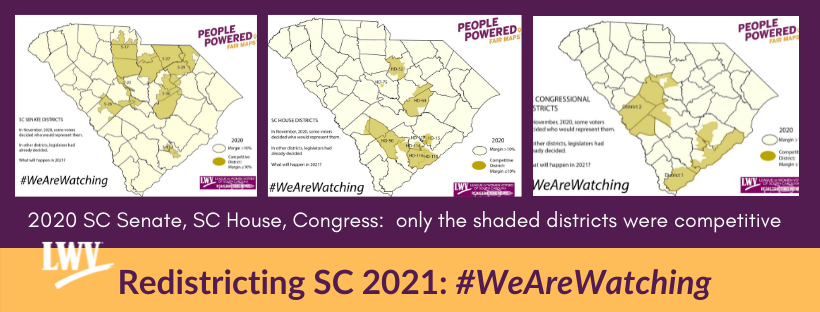Senate
The Redistricting Subcommittee of the Senate Judiciary Committee met today (Chairman Rankin and Senator Harpootlian in person, others virtually) to discuss the guidelines and criteria to be used by the Senate and the process for third parties (such as our various organizations) to submit maps.
Chairman Rankin opened by mentioning the Senate statewide hearings, which were well attended. The Chairman indicated that aversion to incumbent protection was a frequent theme.
Discussion centered on draft guidelines provided by Senate staff (not yet publicly available.) Senator Harpootlian has sent his subcommittee colleagues a letter asking for changes in six aspects of the proposed criteria, and his recommendations were a focus of much of the meeting.
Senator Harpootlian’s concerns ranged from the percentage deviation permitted in defining districts (he argued for a ±1 person variation for the Senate, like that used for Congressional maps) to requests for clarifying language. He argued for explicit rejection of the non-retrogression standard used in defining minority districts in 2011 (now invalidated by federal courts) and specific definition of the hierarchy of criteria, placing incumbent protection at the lowest rung of priorities. In general, Senator Harpootlian emphasized the importance of making maps that are about voters, not legislators, and said that his proposals were directed toward that goal.
None of Senator Harpootlian’s amendments were adopted by the subcommittee, but we can hope that the lively discussion will inform the work of the senators and staff as they proceed.
Senator Bright Matthews moved that “language” be added to the variables on which communities of interest might be based. The Subcommittee approved this motion.
The subcommittee also took up a matter of great interest to all of us, the schedule for ongoing redistricting work. President Peeler recently sent out a letter saying that the Senate would return on October 12 to take up redistricting. Chairman Rankin indicated that this will not be possible, that maps cannot be ready for full Senate consideration that soon. The committee proceeded to set October 8 as a deadline for submission of maps by third parties.
The Senate will establish a portal on their redistricting page for submission of complete statewide redistricting maps, to be provided in ASCII with specific guidelines for column formats. The portal and instructions have not yet been posted, but presumably will be posted in the near future.
Senator Harpootlian initiated discussion of how citizens are to submit their map proposals if they are not able to handle this technical approach. Senator Rankin responded that any maps sent in by citizens through the usual mail or email submission process would receive consideration and that senators could also offer floor amendments based on the concerns of their constituents.
House
House statewide hearings are not receiving the attendance that the Senate hearings did. In part, this may be a consequence of the absence to date of virtual testimony options. However, virtual testimony will be permitted on October 4.
Video of House hearings is being posted at https://www.scstatehouse.gov/video/archives.php.
The House has released no additional information on schedule or process but the rumors around the State House (aka Rumor Mill Central) are that the House will not get to the point of returning for a floor vote until November or even early December. Again, this is not an estblished fact. It is, however, consistent with some other information that follows.
League of Women Voters Map Event
The LWVSC plans to make its maps public on September 29 in a virtual Zoom-based event, “What Would Fair Maps Look Like?” It is free and open to all who are interested. We will outline our process and explain our criteria and our reasoning. We encourage all of you to register and attend. You can register at https://www.eventbrite.com/e/what-would-fair-maps-look-like-tickets-168718235785.
